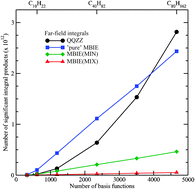Tighter multipole-based integral estimates and parallel implementation of linear-scaling AO–MP2 theory
Abstract
Within an atomic-orbital-based (AO-based) formulation of second-order Møller–Plesset perturbation theory (MP2), we present a novel screening procedure which allows us to preselect numerically significant two-electron integrals more efficiently, especially for large basis sets. The screening is based on our recently introduced multipole-based integral estimates (MBIE) method [J. Chem. Phys., 2005, 123, 184102], that allows to exploit the 1/R4 or 1/R6 coupling between electronic charge distributions in transformed integral products within AO–MP2. In this way, linear scaling is attained with fully-controlled numerical accuracy. Furthermore, a parallel implementation of our linear-scaling AO–MP2 method is described, which also allows us to perform calculations with larger basis sets. First calculations reveal that for e.g. linear

- This article is part of the themed collection: Explicit-r12 correlation methods and local correlation methods

 Please wait while we load your content...
Please wait while we load your content...